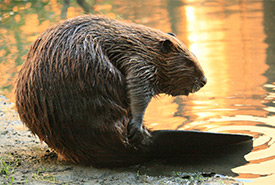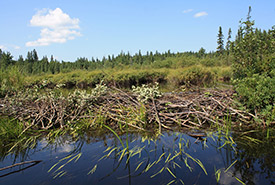Beavers: An inconvenient species?

Beaver (Photo by Cheryl Reynolds)
The beaver is quite a package: it swims like a fish, cuts like a chain saw, moves materials like a front end loader, is the first water engineer and the first logger and transforms landscapes at a scale that rivals human-based transformations. Some might consider them an inconvenient species.
As our national symbol the beaver is equally loved, hated and universally misunderstood. They can come with horns or halos. When they flood roads and property, cut favourite trees they can seem evil incarnate. To the myriad of plant, insect, fish and wildlife species beavers create habitat for and to those that appreciate biodiversity, beavers are divinely inspired. In that balance beavers are seriously underrated as a species that can help us weather the storm of climate change.
The essence of climate change is greater variability in our weather. For many landscapes the trend is towards warmer and drier conditions. It may also mean more violent storms that dump massive amounts of rain in a short time period. It’s a conundrum of generally less precipitation overall, but delivery faster than the landscape can absorb. In a perverse way it means increased drought and flood conditions, often within the same year.
What beavers do, and have done for centuries, can mitigate some of this increased variability. We may have overlooked a natural ally in our efforts to conserve and manage water.
When a beaver hears running water it clicks the switch into dam building mode. Deeper water is a safer home for beavers. Beaver dams create impoundments of stored water; often of significant volume. Research indicates that beaver activity can increase the amount of open water in a watershed by nearly 10 per cent. But that’s only the water we can see. Beneath the ponds and adjacent areas is a much more profound story. Multiply the volume of surface water by five to 10 times to get a picture of hidden ground water storage.

Beaver dam (Photo by Franklin Vera Pacheco)
Beaver ponds both store and deliver water. By allowing water to seep into the ground to shallow aquifers, downstream flows are enhanced from two to 10 times when compared to streams without beavers on them. Most important, that water is delivered later in the season, when flows are normally low (and in drought very low), helping fish survive and providing essential supplies to us downstream water drinkers.
On another front, beaver dams function as speed bumps for streams, slowing down the velocity of moving water. Moving water has incredible power, especially during floods, and can be extremely destructive. An array of beaver dams and ponds in a watershed can delay and reduce the flood peak and the energy associated with that quickly moving mass of water.
Beaver dams increase the width of the effective floodplain up to 12 times. Wider floodplains slow down water by spreading it out. This reduces the erosive force, allowing water to be captured in surface irregularities and eventually some into shallow aquifers. Much of the sediment carried by flood waters is dropped in the floodplain, improving water quality. The impact of a flood is dampened, slowed and reduced, which decreases the negative impacts on downstream communities.
Our attempts to mitigate floods and droughts aren’t always successful and are very costly enterprises. Often engineered structures destroy many natural attributes, fish and wildlife populations are negatively affected and visually the results detract from natural landscapes.
If watersheds had more beaver dams and ponds, this would increase the landscape's ability to capture and tame flood flows, mitigate droughts and better manage risk. Integrating beavers into our future flood, drought and watershed plans can reduce costs and impacts and add substantially to benefits.
The challenge is current beaver populations are a fraction of historical numbers. Population recovery has been slow, partly because we have not fully understood and appreciated the many services provided by beavers and the benefits for us. Another look at beavers will show they are a most convenient species to have as an ally as we adjust to water scarcity and periodic water overabundance.
Did You Know?
Roots is helping to protect Canadian habitat and the species that they sustain, including beavers. Find out how, here.


